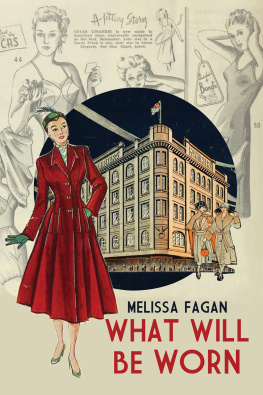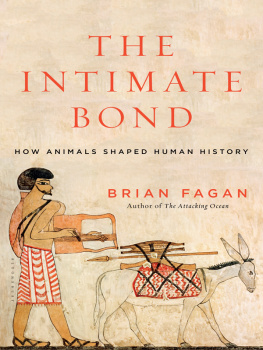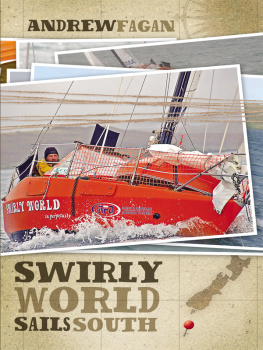WHAT WILL
BE WORN
WHAT WILL BE WORN
A McWhirters story
MELISSA FAGAN


MELBOURNE, AUSTRALIA
www.transitlounge.com.au
First Published 2018
Transit Lounge Publishing
Copyright 2018 Melissa Fagan
This book is copyright. Apart from any fair dealing for the purpose of private study, research, criticism or review, as permitted under the Copyright Act, no part may be reproduced by any process without written permission. Inquiries should be made to the publisher.
Cover design by Peter Lo
Cover images: State Library of Queensland
Internal cover image: Thomas Ryan Photography
Typeset in Janson 12/17pt by Cannon Typesetting
Printed in Australia by McPhersons Printing Group
A cataloguing-in-publication entry is available from the
National Library of Australia: trove.nla.gov.au
ISBN: 978-1-925760-14-9
For my mother, Jill
FOREWORD
What Will Be Worn started life as a story about my grandparents: the grandfather who gambled away his inheritance, the grandmother who had an affair, and the legacy emotional and otherwise they left behind. This is a story about middle-class families, I thought its about my middle-class family: how wealth and prestige were gained and lost and gained and lost again; how patterns are repeated through time and across generations. Its about a family that was once well-known, whose name is still well-known because of the building in Brisbanes Fortitude Valley that still bears its name: McWhirters.
Its more complicated than that, though. Stories about families always are.
For me, at its heart, What Will Be Worn was never a story about a building or a name. I have had to reckon with both, and my own feelings about both, but as the granddaughter of a woman who was cast out from Brisbane society, the granddaughter of a man who was considered the black sheep of his prominent Brisbane family, I have grown progressively wary of my own deep-seated sense of illegitimacy, my subconscious urge to reclaim what was lost. I did not grow up in Brisbane, and I never met my grandfather, Stirling McWhirter he died before I was born. There is nothing to reclaim. I have lost nothing that was not mine to begin with.
In many ways this is my mothers story more than it is my grandparents or mine. It is about how she was born into wealth and a name that mattered, and lost both. But I could not tell my mothers story without telling her mothers story, and I could not write their stories without writing mine. So ultimately What Will Be Worn is about my grandmother, my mother and me and the women who came before us. It is a story I inherited but which I also chose to tell, because I could, and because I owed it to these women who did not have the opportunity to tell their own stories, or to make their lives their own.
PART ONE
THE ROMANTIC RISE OF AGNES CAMERON
The steamer Chimborazo, on a voyage to Australia in 1878, had on board a Scot who, 20 years later, was to set the foundations of a business that to-day needs a floor space of six and a half acres. The expansion of McWhirters, Ltd., from a small two-storied Brunswick-street drapery shop to the block of four floors, housing a bewildering variety of goods, makes a heartening story in times when the voice of the pessimist is too frequently heard.
The Romantic Rise of McWhirters During 33 years
The Brisbane Courier, 4 August 1931
A FEW YEARS BEFORE I moved to Brisbane, the son of one of my mothers friends opened a rooftop bar on Brunswick Street in the Valley. Whenever I came to visit her, my mother and I would go there, ride the private elevator to the fourth floor, order two glasses of champagne and perch ourselves on two bar stools on the open-air balcony at the corner of Wickham and Brunswick streets. We would sit there, as the night air closed in around us, sipping champagne and smoking cigarettes above the peak-hour traffic now at a halt, gazing out at the McWhirter building.
I remember the first time I took her there, or imagine that I do, how she lit a cigarette and took a drag and stared out across the dusky sky, how a coy half-smile spread across her face, and her eyes lit up with what might have been wonder or pride or an acute sense of loss, or perhaps either in that moment or in my memory a verisimilitude of these emotions. I can see her now, turning her back on the building and towards me, how she would have said something about how beautiful it was, or how it seemed surreal to be sitting there, so close to it, that it was almost as though you could reach out and touch it. How she would have taken another drag of her cigarette, then launched into a story about her day at work. How she would have bored me with the mundane details of her job the people she worked with and the petty office power plays as though I, too, had a vested interest in their lives.
I also remember going back again after the smoking laws had changed; you could only smoke in a small section at one end of the balcony, and my mother insisted we sit there so she could smoke, even though it was further up Brunswick Street, away from the corner, away from the view. I was disappointed that she chose cigarettes over my romantic notion of enjoying a sunset drink with a point-blank view of the McWhirter building. I shouldnt have been; that choice if you can call an addicts actions a choice was completely consistent with every choice she has ever made, that she keeps making, even now, when a packet of cigarettes costs almost as much as a bottle of good French Champagne.

My mothers friends son sold the bar a few years ago. The new owners refurbished it and relaunched yet another Valley nightclub, which claims on its website to be the heart of Brisbanes glamour scene. I couldnt go there now for a sunset drink even if I wanted to; it doesnt open until 9 p.m. Not that you have to drink, or for that matter smoke, at a rooftop bar at sunset to catch a glimpse of the McWhirter building. If youre driving past it, along the one-way Wickham Street, or waiting at the traffic lights on the northern side of Brunswick Street, all you have to do is look up. Youll see the distinct terracotta brickwork, with its rosettes and diamond decals in yellow, blue and ochre, its pillars that rise to an arch. Youll see, at the very top, set into the arch, the McWhirter monogram: an M and a W that interlock, overset with a superscript c. Youll see how its bound by a floral wreath that may or may not be lily of the valley. And below it, spanning the concertinaed entranceway, youll see the buildings name: McWhirters. My grandfathers and great-grandfathers and great-great-grandfathers name. The name my mother was born with.
The McWhirter building occupies a whole block over an acre of land but it is this part of the building fronting Valley Corner, at the intersection of Wickham and Brunswick streets, which people think of when they think of McWhirters. This corner building, with its striking Art Deco facade, was constructed swiftly, over seven months at the height of the Great Depression. Yet it was the culmination of a much longer work-in-progress, which began in 1898 with the opening of McWhirter & Son, and a vision that dates back almost that far: to have the family name emblazoned across the entire block.
McWhirter & Son bought the corner block in 1899, or so I have read, and commissioned architect Richard Gailey to draw up plans for a new building. Gailey designed some of Brisbanes finest buildings of the late Victorian era, including the Regatta Hotel at Milton, and Moorlands, the Mayne family home. His vision for McWhirter & Son appeared in a full-page ad in
Next page















